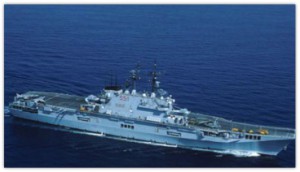
08/27/2011 The Libyan operation has highlighted the use of maritime bases for conducting air operations. In a recent interview with Col. Mark Desens, the Commanding officer of 26th Marine Expeditionary Unit involved in the initial Libyan operations, the ability to operate 100 miles off of the Libyan shores to shape effective air operations was highlighted:
“We were able to fly the Harriers, when other aircraft could not fly. And we were not externally tanker dependent, and when we did use tanking could use our organic tanking capability. And given the rapid turn around of aircraft from the Kersarge, we were able to pass ISR date from one strike package to the next to prosecute successfully against regime assets deployed on the ground. The ability to operate offshore meant that we were able to have significant sortie rates compared the much longer lead times fixed wing aircraft needed to operate from England or Italy.”
This is something akin to the rebirth of the MEU ironically off of the shores of Tripoli!
A similar perspective has been provided by Italian operations.
Libya marks the 6th operational use of Harriers (STOVL capability) since the Italians received them in 1994, and they have proved useful in Somalia, Albania, former Yugoslavia, Afghanistan and Lebanon.
With their ability to operate in close proximity to warzones, fuel consumption is less of a worry, as well as reduced wear and tear. With less reliance on in-flight refueling, pilots can concentrate on dynamic tasking, and fluid operations. From this perspective, the Italians find that they cost less to operate than Tornadoes and Eurofighters. And this fact is especially significant, given the age of the Harriers.
Rear Admiral Paolo Treu, Chief of Italian Naval Aviation underscored that “Libya Is Really Showing That These Aircraft and the Carrier Are Needed . . .”
And the Rear Admiral emphasized that the transition to the F-35B was something he viewed as essential to Italian capabilities going forward:
“Having a Carrier in 2020 That Uses Legacy Aircraft (4th Gen) in a Threat Situation Means Having A Carrier You Cannot Use . . .”
“Carrier-Based Harriers Are a Valid Instrument for Intervention for Italy Whether Far From Home or close by as in Libya. If Italy Wants To Keep This Capability It Needs the JSF . . .
It would be useful on occasion when the Senator McCain’s of the world pontificate on the F-35 that they might remember the centrality of this program to allies and the ability to do coalition operations. The Italians are clearly a case in point. There are building a final assembly facility in Italy with an investment of more than one billion dollars and acquiring an aircraft carrier on the expectation that it will be populated with 5th gen F35 -Bs.
So who is on probation: the F-35B or Washington’s ability to work with allies?


